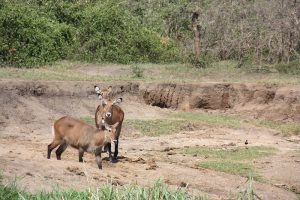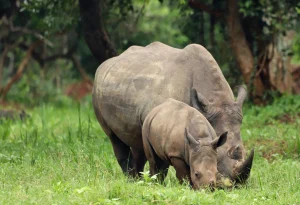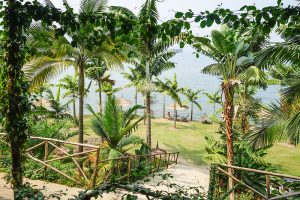Is gorilla trekking guaranteed in Uganda?
Seeing gorillas in Uganda is an awe-inspiring and deeply moving experience that offers a rare glimpse into the world of these majestic primates. Embarking on a gorilla trekking adventure in Uganda allows visitors to venture into the lush and mist-covered forests of Bwindi Impenetrable National Park and Mgahinga Gorilla National Park, where nearly half of the world’s mountain gorilla population resides. Led by experienced guides and trackers, trekkers navigate rugged terrain and dense vegetation in search of gorilla families, immersing themselves in the breathtaking beauty of Uganda’s landscapes along the way. Is gorilla trekking guaranteed in Uganda?
The question is gorilla trekking guaranteed in Uganda: upon encountering these gentle giants, visitors are rewarded with a profound and unforgettable experience, as they observe the gorillas’ intricate social dynamics, playful behaviors, and soulful eyes that seem to reflect a shared ancestry with humans. The opportunity to see gorillas in Uganda not only offers a rare wildlife encounter but also contributes to conservation efforts, ensuring the protection of these critically endangered primates and their habitats for future generations to cherish and enjoy.
Are you guaranteed to see gorillas in Uganda?
While Uganda’s gorilla trekking experiences offer high chances of encountering mountain gorillas, sightings are not guaranteed. Mountain gorillas inhabit dense and remote forests, making them wild animals with unpredictable movements. However, the guides and trackers accompanying trekkers are highly skilled at locating gorilla groups based on their recent movements and behaviors. Additionally, the trekking permits limit the number of visitors per gorilla group, reducing disturbance and increasing the likelihood of meaningful sightings. Despite these efforts, factors such as weather conditions, the gorillas’ movements, and the dense vegetation can influence visibility during treks. While most trekkers do indeed have successful encounters, it’s essential to approach gorilla trekking with the understanding that wildlife sightings are subject to natural variability, and patience and appreciation for the overall experience are key.
Several factors can limit the likelihood of seeing gorillas during a trekking expedition:
Weather Conditions:
Heavy rainfall or dense fog can reduce visibility in the forest, making it more challenging to locate gorilla groups.
Gorilla Movements:
Mountain gorillas are wild animals with large home ranges, and their movements can be unpredictable. They may move to areas that are inaccessible or difficult to reach for trekkers.
Vegetation Density:
The dense vegetation in gorilla habitats can obstruct views and make it challenging to spot gorilla groups, especially if they are deep within the forest.
Terrain Difficulty:
Trekking through rugged terrain, steep slopes, and thick undergrowth can slow down progress and limit access to gorilla habitats.
Group Allocation:
Gorilla trekking permits specify a particular gorilla group to visit, and while efforts are made to match groups with visitors’ preferences and fitness levels, some groups may be more challenging to reach than others.
Gorilla Behaviour:
Gorillas are wild animals, and their behavior can be influenced by various factors such as feeding patterns, social interactions, or disturbances from other wildlife or humans. In some cases, gorilla groups may be more elusive or may retreat deeper into the forest, making sightings more challenging.
How to book a gorilla trekking permit?
Booking a gorilla trekking permit in Uganda typically involves several steps:
Choose Your Dates
Decide on the dates you would like to trek with the gorillas. It’s advisable to book well in advance, as permits can sell out quickly, especially during the peak tourist seasons.
Select a Tour Operator or Park Authority
Gorilla trekking permits in Uganda are typically obtained through registered tour operators or directly from the Uganda Wildlife Authority (UWA), which manages the national parks. Research reputable tour operators like Abunda Discoveries Uganda or contact the UWA directly for permit availability.
Contact the Operator or UWA:
Reach out to your chosen tour operator or the UWA to inquire about permit availability for your preferred trekking dates. Provide them with information about the number of permits you need and any specific preferences you may have regarding the gorilla group or park sector you wish to visit.
Confirm and Pay:
Once availability is confirmed, you will need to secure your permits by making payment. Payment methods may vary depending on the tour operator or UWA policies but typically involve bank transfers or online payment platforms.
Provide Required Information:
You may need to provide personal information such as passport details for each participant to finalize the booking process. Ensure that all information provided is accurate and matches the requirements of the permit issuer.
Receive Confirmation:
After payment is received and all necessary information is provided, you will receive confirmation of your gorilla trekking permit booking. This confirmation may include details such as the trekking date, park sector, meeting point, and any additional instructions.
Prepare for Your Trek:
Once your permit is confirmed, make any necessary travel arrangements and ensure you have all the required gear and documents for your gorilla trekking adventure.
Guaranteed Gorilla Habituation Experience Safari in Bwindi Forest
It’s essential to book your gorilla trekking permit well in advance, as permits are limited and can sell out months in advance, especially during the high season. Additionally, be sure to read and understand the booking terms and conditions provided by your chosen tour operator or the Uganda Wildlife Authority for more information, you can reach us via our email: info@abundadiscoveriesuganda.com
What is the age limit for gorilla trekking in Uganda?
In Uganda, the minimum age limit for gorilla trekking is typically set at 15 years old. This age restriction is in place to ensure the safety of both the visitors and the gorillas. Gorilla trekking involves hiking through rugged terrain and dense vegetation, which can be physically demanding and challenging for younger children. Additionally, gorillas are wild animals, and encounters with them require visitors to follow specific guidelines to minimize disturbance and ensure the well-being of the gorillas and their habitat. Younger children may have difficulty understanding and adhering to these guidelines, increasing the risk of unintentional disruptions during the trek. By setting a minimum age limit, Uganda’s authorities aim to prioritize the safety of visitors and the conservation of gorillas while still allowing older children and adults to enjoy this remarkable wildlife experience responsibly.
What is considered the best time for gorilla trekking?
The best time for gorilla trekking in Uganda is generally during the dry seasons, which typically occur from June to September and December to February. Several factors make these periods optimal for gorilla trekking:
Weather:
The dry seasons are characterized by lower rainfall and clearer skies, making trekking conditions more favorable. Rainfall during the wet seasons can make trails muddy and slippery, increasing the difficulty of trekking and reducing visibility in the forest.
Gorilla Movements:
During the dry seasons, gorillas tend to stay closer to the trails and lower elevations, making them more accessible to trekkers. With reduced foliage and clearer paths, guides can more easily track gorilla movements, increasing the chances of successful encounters.
Vegetation:
The dry seasons coincide with periods of fruiting in the forest, which disperses gorillas less and makes them more predictable in their movements. This increases the likelihood of finding gorilla groups during treks.
Tourist Numbers:
The dry seasons are peak tourist seasons in Uganda, with more visitors flocking to the country for wildlife experiences. While this means more competition for permits, it also increases the likelihood of meeting other travelers with similar interests and sharing the experience.
Overall, the dry seasons offer the best combination of weather, gorilla behavior, and trekking conditions, making them the preferred time for gorilla trekking in Uganda. However, it’s essential to note that gorilla trekking can be undertaken year-round, and each season offers its unique advantages and experiences.
A suggested packing list while going for gorilla trekking guaranteed in Uganda?
Sturdy Hiking Boots
Waterproof, comfortable hiking boots with good ankle support are essential for navigating uneven terrain and protecting your feet.
Long Pants and Long-Sleeved Shirts
Lightweight, moisture-wicking clothing that covers your arms and legs to protect against scratches, insect bites, and vegetation.
Waterproof Jacket or Poncho: A lightweight, waterproof jacket or poncho to protect against rain and mist in the forest.
Hat and Sunglasses
A wide-brimmed hat and sunglasses to shield your face and eyes from the sun.
Gloves
Thin gloves to protect your hands from scratches, insect bites, and cold temperatures, especially in the early morning.
Daypack
A small, lightweight backpack to carry essentials like water, snacks, a camera, and personal items during the trek.
Water Bottle: A refillable water bottle to stay hydrated throughout the trek, especially in the humid forest environment.
Energy Snacks
Lightweight, high-energy snacks like nuts, energy bars, or dried fruit to keep your energy levels up during the trek.
Insect Repellent
Insect repellent containing DEET or other effective ingredients to ward off mosquitoes and other insects.
Sunscreen
Sunscreen with high SPF to protect exposed skin from harmful UV rays, even on cloudy days.
Binoculars
Optional but useful for spotting wildlife and birds in the forest from a distance.
Camera
A camera or smartphone to capture the unforgettable moments of your gorilla encounter.
Portable Charger/Batteries:
Ensure your electronic devices stay powered throughout the trek, especially if you plan to use your camera or smartphone extensively.
Personal Medications and First Aid Kit
Carry any necessary medications and a basic first aid kit for minor injuries or ailments.
Leisure Clothing for After Trek
Comfortable, moisture-wicking clothing to change into after the trek, preferably with long sleeves and pants to protect against sunburn and insect bites.
Plastic Bags
Extra plastic bags for storing wet or dirty clothing and trash to leave no trace in the forest.
Remember to pack light and efficiently, as you’ll be carrying your daypack during the trek. Additionally, check with your tour operator or guide for any specific recommendations or requirements for your gorilla trekking adventure.
Accommodation for gorilla trekking in Bwindi?
Bwindi Lodge
Bwindi Lodge is a luxurious accommodation option nestled on the edge of the Bwindi Impenetrable Forest, offering stunning views of the forest canopy. The lodge features comfortable and spacious cottages with en-suite bathrooms, private verandas, and fireplaces to keep you warm during chilly evenings. Guests can enjoy delicious meals at the lodge’s restaurant, relax in the cozy lounge area, or unwind with a drink at the bar. Bwindi Lodge provides a luxurious retreat after a day of gorilla trekking, with prices ranging from $400 to $800 per night, depending on the season and room type.
Mahogany Springs Lodge
Mahogany Springs Lodge offers a tranquil and intimate setting near the entrance to Bwindi Impenetrable National Park. The lodge features elegant and spacious rooms with large windows offering panoramic views of the surrounding forest. Guests can indulge in delicious meals at the on-site restaurant, unwind with a massage at the spa, or simply relax on the terrace overlooking the lush gardens. Mahogany Springs Lodge provides a comfortable and convenient base for gorilla trekking adventures, with prices ranging from $250 to $500 per night, depending on the season and room category.
Gorilla Safari Lodge
Gorilla Safari Lodge is an eco-friendly accommodation option located in the foothills of the Virunga Volcanoes, offering breathtaking views of the forest and surrounding landscape. The lodge features cozy cottages and spacious suites with private verandas, en-suite bathrooms, and rustic furnishings inspired by local craftsmanship. Guests can Savor delicious meals at the lodge’s restaurant, relax by the fireplace in the lounge area, or take a dip in the outdoor pool surrounded by lush vegetation. Gorilla Safari Lodge provides a serene and immersive experience in nature, with prices ranging from $200 to $400 per night, depending on the season and accommodation type.
Buhoma Lodge
Buhoma Lodge is a charming accommodation option situated within walking distance of the Buhoma Gorilla Trekking starting point in Bwindi Impenetrable National Park. The lodge features comfortable chalets with en-suite bathrooms, private verandas, and stunning views of the forest canopy. Guests can enjoy delicious meals at the lodge’s restaurant, relax in the cozy lounge area, or take a guided nature walk to explore the surrounding area. Buhoma Lodge offers a convenient and authentic experience in the heart of gorilla territory, with prices ranging from $300 to $600 per night, depending on the season and room category.
Silverback Lodge
Silverback Lodge offers a secluded and rustic retreat overlooking the Buhoma area of Bwindi Impenetrable National Park. The lodge features cozy cottages with en-suite bathrooms, private balconies, and warm furnishings crafted from local materials. Guests can dine on delicious meals at the lodge’s restaurant, relax by the fireplace in the lounge area, or take in the stunning views from the outdoor terrace. Silverback Lodge provides a comfortable and affordable option for gorilla trekking enthusiasts, with prices ranging from $150 to $300 per night, depending on the season and room type.
What other activities to participate in after gorilla trekking in Bwindi?
After gorilla trekking in Bwindi Impenetrable National Park, there are several other activities to enjoy in the surrounding area and these include:
Golden Monkey Trekking
Bwindi Impenetrable National Park is not only home to mountain gorillas but also to the endangered golden monkeys. Golden monkey trekking offers another unique wildlife experience, allowing you to observe these playful primates in their natural habitat.
Bird Watching
Bwindi is a haven for birdwatchers, with over 350 bird species recorded in the park, including many Albertine Rift endemics. Guided birdwatching tours offer the opportunity to spot colorful and rare bird species amidst the lush forests.
Nature Walks and Hiking Trails
Explore the diverse landscapes of Bwindi through guided nature walks and hiking trails. Discover scenic viewpoints, cascading waterfalls, and rich biodiversity as you trek through the park’s varied terrain.
Cultural Encounters
Engage with local communities and learn about their traditional lifestyles, customs, and cultural heritage. Visit nearby villages to interact with residents, participate in cultural performances, and gain insights into their way of life. Is gorilla trekking guaranteed in Uganda?
Batwa Cultural Experience
Gain a deeper understanding of the indigenous Batwa pygmies, who were once forest dwellers in Bwindi. Take part in a Batwa cultural experience, where you can learn about their history, traditions, and survival skills.
Community Visits and Crafts Markets
Support local communities by visiting nearby villages and craft markets. Purchase handmade souvenirs, traditional crafts, and locally produced goods while directly benefiting local artisans and their families.
Scenic Drives and Photography
Take leisurely drives through the picturesque countryside surrounding Bwindi, soaking in the stunning landscapes and capturing memorable photographs of the lush forests, rolling hills, and vibrant communities.
Relaxation and Wellness
Unwind and rejuvenate after your gorilla trekking adventure with a spa treatment or massage at one of the nearby lodges or wellness centers. Treat yourself to some well-deserved pampering amidst the tranquillity of the forest.
These activities offer the perfect complement to your gorilla trekking experience, allowing you to further immerse yourself in the natural beauty, wildlife, and culture of Bwindi Impenetrable National Park and its surrounding areas. Is gorilla trekking guaranteed in Uganda?
Why book gorilla trekking in Bwindi with Abunda Discoveries Uganda
Booking gorilla trekking in Bwindi with Abunda Discoveries Uganda offers several compelling advantages. First and foremost, We boast extensive experience and expertise in organizing gorilla trekking expeditions, ensuring a seamless and unforgettable adventure for travelers. Their knowledgeable guides are well-versed in the behavior and habitat of mountain gorillas, enhancing the overall trekking experience with insightful commentary and expert guidance.
Additionally, Abunda Discoveries Uganda prioritizes sustainable tourism practices and responsible gorilla viewing, minimizing the ecological impact on gorilla habitats while maximizing the benefits to local communities. Moreover, We offer personalized service and attention to detail, tailoring gorilla trekking itineraries to meet the specific preferences and needs of each traveler. With a commitment to excellence, professionalism, and conservation, booking gorilla trekking in Bwindi with us ensures a memorable and ethically responsible wildlife encounter in one of Africa’s most iconic destinations. Is gorilla trekking guaranteed in Uganda?




